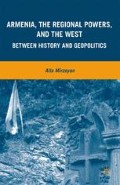Abstract
This chapter labels Iran as the “permanent alternative” in the Armenia’s foreign policy thinking and practice since the beginning of the independence. This term reflects both Iran’s immediate post-1991 role as that of a balancing power vis-à-vis Turkey and Azerbaijan and the Armenians’ perception of their relations with Iran as a political constant. Both countries see each other as one of the paths leading them away from regional marginalization and isolation that results in the use of a similar language of balance and mediation. Armenia uses its relationship with Iran as a semantic tool in formulating and presenting its policy of complementarity. It would have been simply impossible for Armenia to advance this concept and illustrate its raison d’etat without its relationship with this ideological opponent of the West. “Social banks,” consisting of Armenia’s Iran specialists, linguists, and trained diplomatie staff as well as key leadership’s cultural familiarity with the Middle East, grant this relationship certain depth and underlying comfortableness despite certain mutual tensions.
By experience and necessity, our engagement with Iran is not and cannot be superficial and on-and-off again. Nor does it really pose any real or substantial security rfireat to anybody. It does not tilt any strategic balance. Even its economic significance is very minimal on the scale of global, even regional, trade. What we have is rfie cooperation of two neighbors, each resisting different forms of isolation and marginalization.]
Armenia approaches relations wirfi Iran as a political constant regardless of any potential political developments in the future. Armenia is absolutely unequivocal in claiming rfiat diese two countries are connected by a common ancient culture, civilization, communion, etc. Friendly and impartial attitude towards Iran is one of rfie most significant elements of Armenian national “weltanaschauung.”2
Access this chapter
Tax calculation will be finalised at checkout
Purchases are for personal use only
Preview
Unable to display preview. Download preview PDF.
Notes
Eliz Sanasarian, Religious Minorities in Iran, Cambridge Middle East Studies (Cambridge, UK; New York: Cambridge University Press, 2000), p. 35.
Ray Takeyh, Hidden Iran: Paradox and Power in the Islamic Republic, 1st ed. (New York: Times Books, 2006), p. 63.
Edmund Herzig, Iran and the Former Soviet South (London: Royal Institute of International Affairs, 1995), p. 30.
Copyright information
© 2010 Alla Mirzoyan
About this chapter
Cite this chapter
Mirzoyan, A. (2010). Iran: “The Permanent Alternative”. In: Armenia, the Regional Powers, and the West. Palgrave Macmillan, New York. https://doi.org/10.1057/9780230106352_4
Download citation
DOI: https://doi.org/10.1057/9780230106352_4
Publisher Name: Palgrave Macmillan, New York
Print ISBN: 978-1-349-38124-1
Online ISBN: 978-0-230-10635-2
eBook Packages: Palgrave Political & Intern. Studies CollectionPolitical Science and International Studies (R0)

